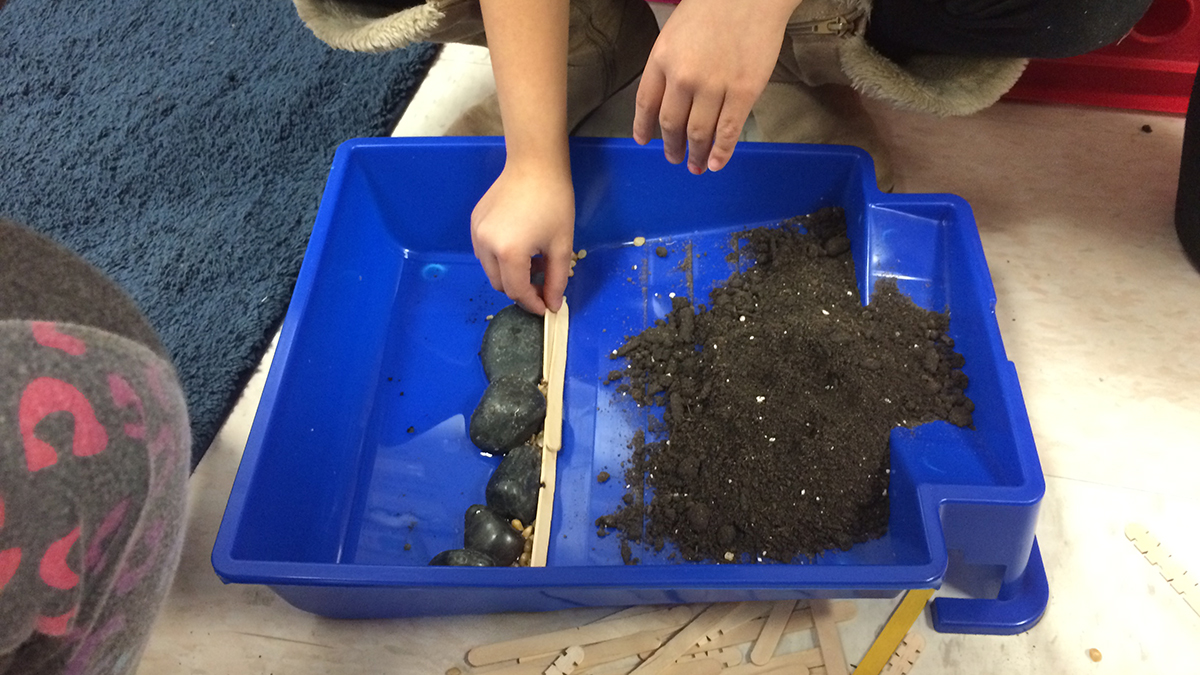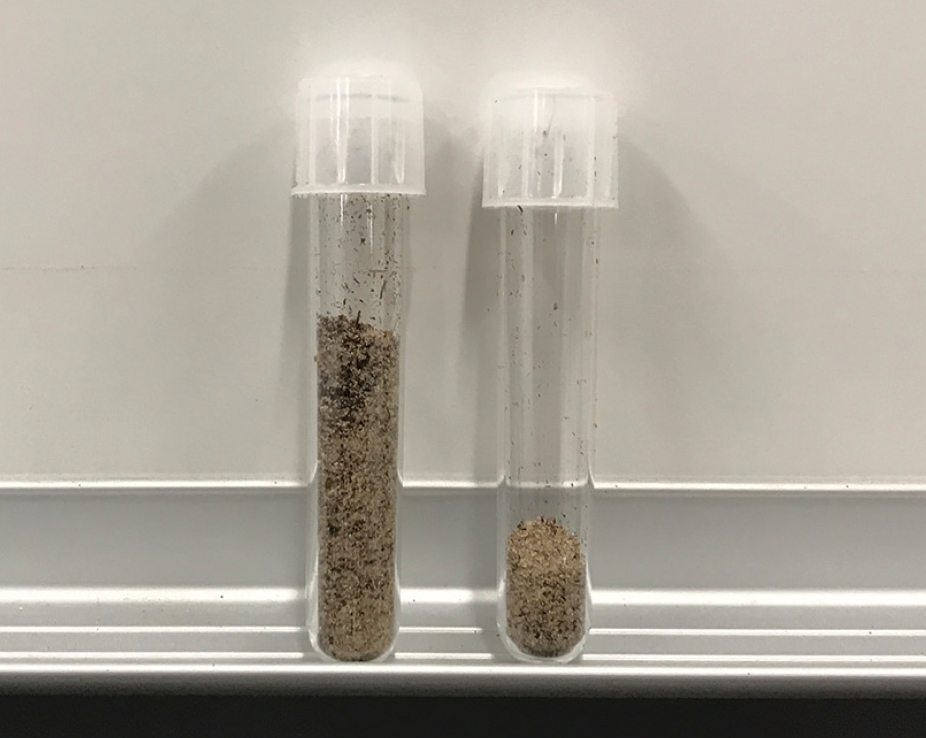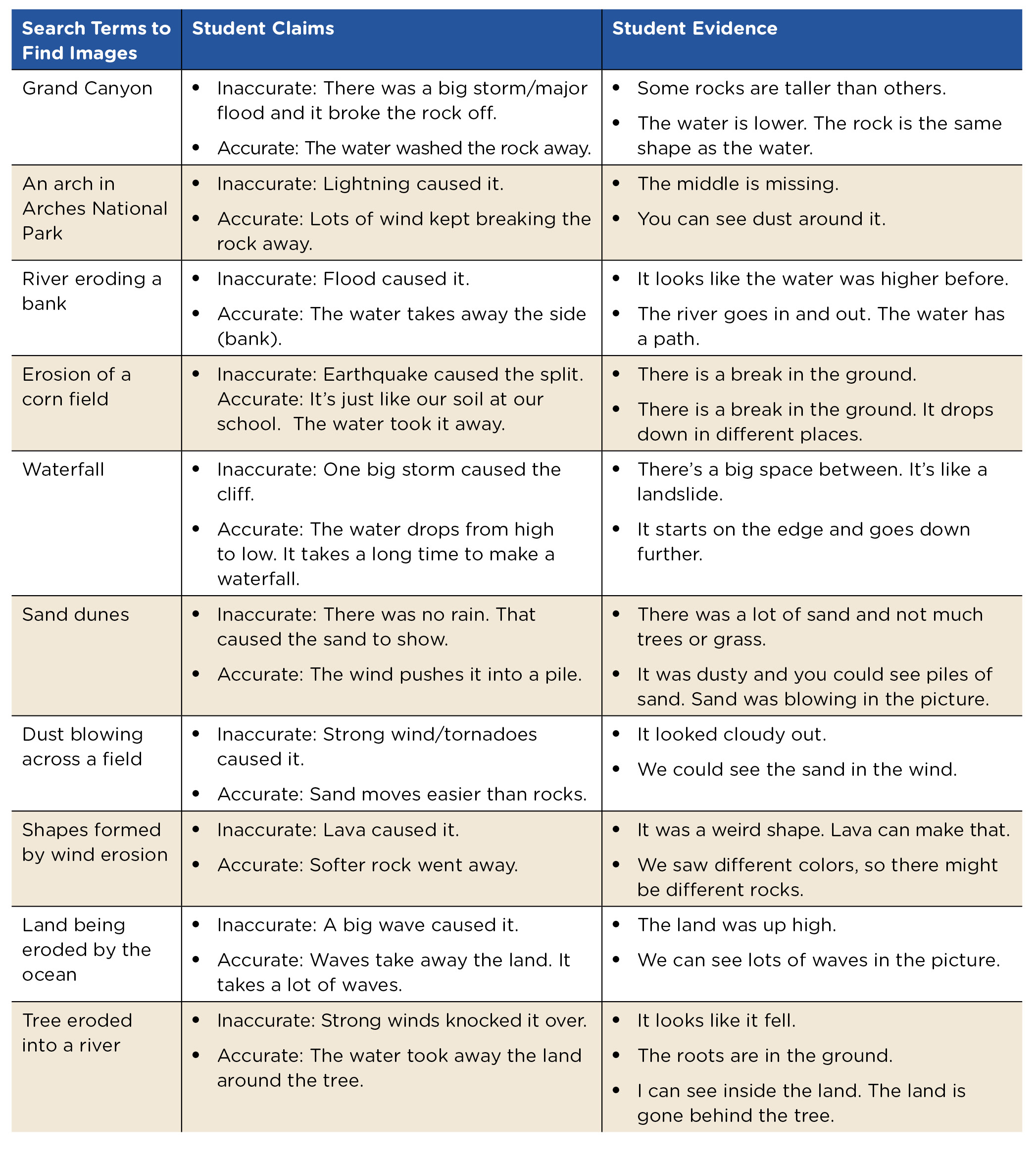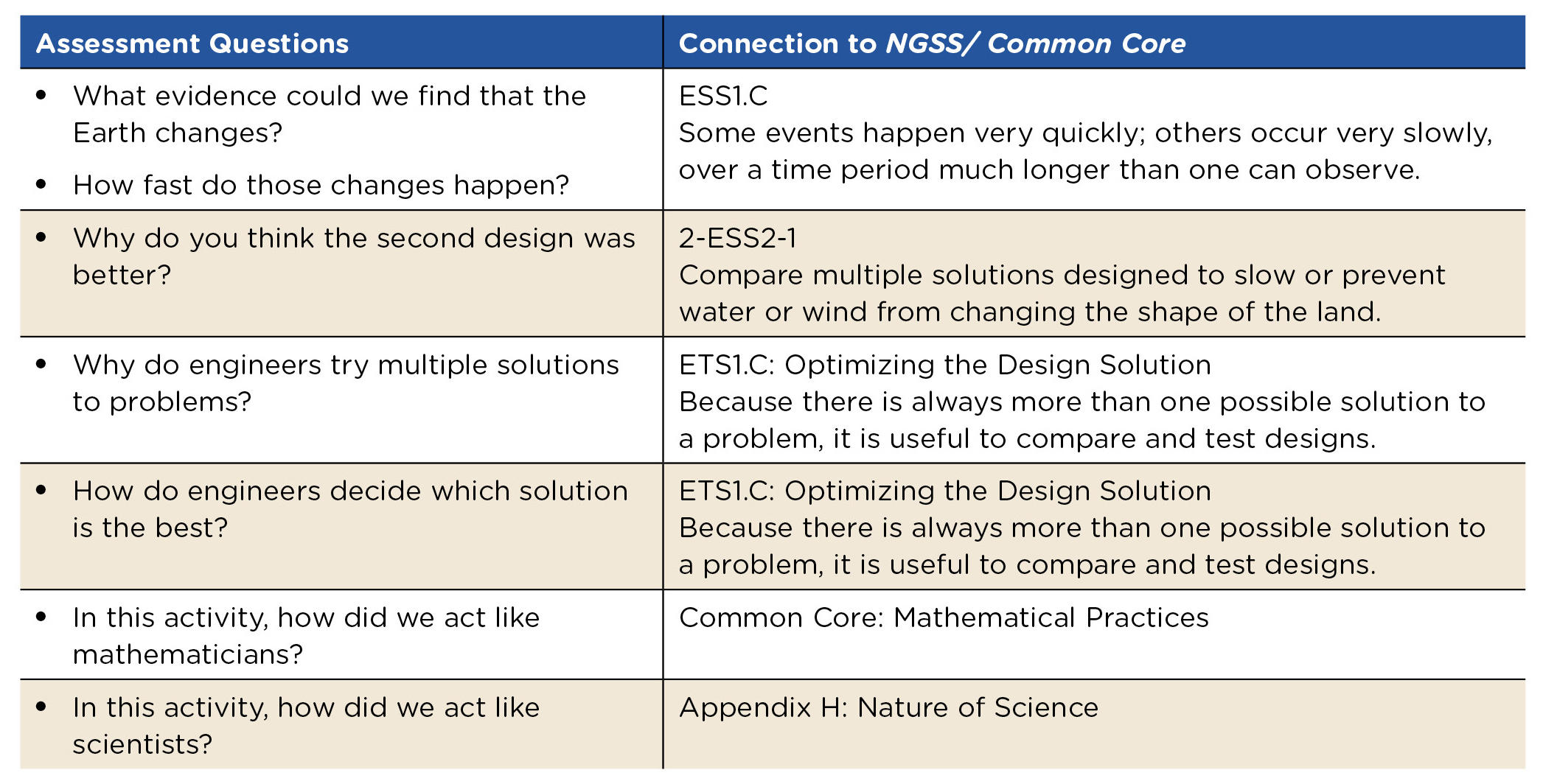feature
Exploring the STEM Landscape
Integrating the natures of STEM into elementary Earth science
Science and Children—July/August 2021 (Volume 58, Issue 6)
By Jesse Wilcox, Jerrid Kruse, and Scott Decker

What does a scientist do? What is an engineer? What is technology? What do mathematicians do? Questions about the nature of STEM are fundamental to help elementary students gain a deep understanding of the STEM disciplines. Yet, starting a lesson with such abstract questions can be difficult for any learner. Instead, teachers can use concrete STEM activities to scaffold elementary students toward understanding the natures of STEM. Specifically, when students are encouraged to act like scientists and engineers through engaging in the science and engineering practices (SEP), questions about the natures of STEM are easier for students to grasp. This article has two major purposes: (1) provide questions worth exploring in the elementary grades regarding the natures of STEM (see Table 1), and (2) demonstrate how the natures of STEM can be embedded into STEM lessons using wind and water erosion as an example.

Day 1: An Intriguing Question
One day the elementary principal mentioned over the loudspeaker that eagles were being observed at the local lake that was recently dredged. Our second-grade students were excited about seeing eagles within two miles of their homes. Students were also a bit confused and began asking about “dredging.” So, we asked, “How could we find out more about dredging?” and one student suggested we “look at pictures on Google.” We showed students images of dredging equipment and asked students to think about why our local lake might have needed to be dredged. One student mentioned, “extra dirt got into the lake.” Then, we asked students to brainstorm how extra dirt might have gotten into the lake. The resulting conversation became a natural introduction to the effects of wind and water erosion.
Day 2: Shared Experience of Erosion
On day 2, we took the students out to the wooded area by the side of our school where some of the land had eroded into a small creek. We asked students to talk in groups about what could have made the land change. Students walked around the area, observed the land, and discussed how the water might have moved the land. We then asked students, “Where do you think the land went?” Students mentioned that the land may have moved down the hill or into the woods. To make connections to the nature of science, we asked, “You observed the soil. Why do you think observations are important in science? Why might scientists want to draw pictures of their observations?” We then formatively assessed students by having them draw a sketch of what they observed. Many students drew some of the soil being further down the hill after it rained. To push students further, we asked, “What types of land did you see other than the soil?” Students mentioned they saw sand and rocks. We used these initial ideas as our starting point for day 3.
Day 3: Exploring Properties of Earth Materials
We started day 3 by putting sand, soil, gravel, and large rocks into separate basins. Be sure to use sterilized materials. If you buy materials from a store, ensure they don’t have fertilizers or other potentially hazardous materials mixed in. Ensure students thoroughly wash their hands after touching soil, sand, and rocks. Make sure students are wearing safety goggles and point the straw away from themselves and other students when testing how wind might erode the landscape.
Students worked in small groups of four to note properties of the different materials by jotting down notes regarding texture (smushy, gritty), hardness (breaks easy, very hard), amounts of pieces (lots of little pieces, one big chunk), and mass of the material (heavy, light). As groups moved to different materials, they left two members behind to work with another group to make new observations. This carousel activity led students to collaborate with different peers who may have brought new ideas to the group. We used this conversation to have students reflect upon their experiences and explicitly connect it to the nature of science. Specifically, we asked, “How did working with each other help you?” “Why might scientists want to work together?”
We then posed a question regarding what they noticed about each material and where they see each material outside. Students responded with practical uses of soil in gardens, sand on beaches, and gravel in driveways. We asked students to predict which of the materials would slide down the hill outside easiest. One student said, “The soil would be easier because it’s small.” Another student said, “When I was on a beach and it was windy, the sand blew around.” Students agreed that smaller materials (soil and sand) would be more likely to move than large rocks and gravel.
Day 4: Eroding of the Land
To help students see how wind and water can erode the land, we gave students a paint tray along with five cups that contained one of the following: gravel, sand, soil, large rocks, and sphagnum moss. We then asked students how earth materials move and they responded with rain, wind, and earthquakes. To model their ideas, each group used a spray bottle to simulate rain, blowing through a straw to simulate wind, and shaking the paint tray to simulate earthquakes. Importantly, before students tested, we asked students how they could use the materials safely. Students mentioned using safety goggles, not shaking the tray too much, and pointing the straw away from people. As students provided suggestions, we modeled their ideas with the materials to ensure students knew what was expected. Students then recorded their predictions and observations in their science notebook. We walked around the room, listened to students’ ideas, and read what they wrote on their notebooks. We were careful not to take on-task students off-task, so when students were ready, they raised their hands. We met briefly with each group and posed questions such as:
- What patterns do you notice? Why might scientists look for patterns?
- What are you noticing about the sand and soil compared to the rocks and gravel?
- How could we keep all of the materials from moving so much?
Day 5: Reducing Erosion
Using what students observed from day 4, we asked students to design a way to keep the wind and water from eroding the land. Students were purposefully grouped using our formative assessments from the previous activities. Specifically, we paired students with varying levels of background knowledge so they could scaffold and support each other (Kagan and Kagan 2013). Each group of students was charged with making a plan as a group and then illustrating their design. After students created their plans, we asked them why engineers might want to make a plan before they started. Students said things like, “the plan can keep mistakes from happening” and “they can share ideas easier.”
Each group then created a model in their paint tray. The students tested out their designs by lightly pouring water into the top of the pan where the soil was and made observations about the effectiveness of their design. Many students had sand and soil exposed on the surface and no way of keeping it from washing “downstream.” The students wanted another chance to make their design better. We used this opportunity to help the students understand the nature of engineering using explicit and reflective questioning. We asked, You want to improve your designs. Why might engineers try to improve their designs? I noticed you wanted to use more than just the sand in your new designs. What types of things might you use? Why might the kinds of materials affect what engineers can build?
To move toward analysis and help students think about the nature of mathematics, we asked students how numbers help us communicate? Students noted that numbers are like words. So we asked, “How can we use numbers to compare our designs?” Students needed some support so we asked, “If we wanted to know if the new design is better than your first design, what could we measure?” Students suggested, “We look at the water before and after.” “We could weigh it.” “We could see how much stuff comes out.” We then scaffolded students through questions to consider the pros and cons of their suggestions. For example, to help students understand that the amount of water would be problematic, we asked, “What do you notice happened to the water when we poured it?” Students noted some of the water drained and some of it “went in the soil.” We then asked, “If some of the water went in the soil, why might measuring the water not work too well?” With our guiding questions, our students decided the best way to analyze their designs would be to measure how much sand and soil came out. We then asked students how they could separate the water from the soil and sand. Students noted we could dry the sand, soil, and water runoff and we would just have the sand and soil. After school, we heated the mixtures to remove the water.
Day 6: Redesigning the Landscape
Students were given an additional day to redesign their landscapes, which led to a great deal of discussion within student groups about how to improve upon their first designs by keeping the land in place using more rocks and moss. Students had a great deal more success on the second day. Once students finished their landscapes, we asked explicit and reflective questions about the nature of technology such as:
- A lot of people think technology is only computers, cell phones, and other electronics. In what way was our landscape design a technology?
- How might using technology to control erosion cause new problems?
- How do you think farming technology has affected erosion in good and bad ways?
Day 7: Comparing Designs
We started this day by giving student groups their sand/soil runoff from both the first and second iterations of the landscape (Figure 1). We then asked students to determine which of their versions worked the best. They decided to measure the length of the samples and compare them to each other. We then asked, “Why might it be good to look at all of the group’s measurements rather than just one group?” Students said things like, “I want to see what other people did too”, “It can help us make sure we are right.” We created a t-chart on the board that had the beginning and end measurements for each group and students quickly realized the second version worked much better at avoiding runoff than the first. We then asked students some explicit and reflective questions regarding the nature of math and engineering such as:

- Why do you think our second designs looked like they worked better? Why do you think it’s good that engineers keep trying to improve their designs?
- How do you think using numbers in our table affected our thinking? How could you compare your designs without numbers?
- How did math help us understand which design worked better? Why might scientists and engineers use math in their work?
Day 8: Applying the Activities to Real Landscapes
To help students apply the landscape activity to real life, students looked through 10 images of different landscapes and shared in trios what they noticed in each picture (see Table 2). We used a claims and evidence discussion to introduce the crosscutting concept of stability and change by asking, “What evidence do you have from the pictures that the landscape probably changed over a long time?”


Strategies for teaching the natures of STEM.
Accurately Modeling Nature of STEM
- Start the lesson/unit with an exploratory activity that will likely increase student interest and involve multiple Science and Engineering Practices.
- Appropriately structure the activity—without structuring students’ thinking—to ensure students’ experience accurately models what scientists, mathematicians, and engineers do.
- Where appropriate, have students develop their own questions and procedures.
- Guide students with open-ended questions and discuss the activity with students.
Explicit & Reflective Nature of STEM Teaching
- Explicitly teach students through videos, readings, and discussions what a scientist, engineer, and mathematician are and what they do.
- During the activity, listen to student conversations for ways in which they are acting like scientists, engineers, and mathematicians (e.g., collaboration, creativity, using a variety of methods, changing their ideas, making models).
- Ask students to reflect on nature of STEM ideas (e.g., In what ways did you have to work together during this activity?).
- Follow up the reflective question by explicitly asking students to connect the nature of STEM idea to a scientist, engineer, or mathematician (e.g., Why do you think mathematicians work together?).
- Include a variety of nature of STEM activities (e.g., blackbox activities, puzzles, inquiry labs, historical short stories) and scaffold between them (e.g., how was ______ activity like ____ activity?).
- Explicitly teach each nature of STEM idea multiple times throughout the year and in multiple contexts.
Assessing Nature of STEM
- Use a Draw-a-Scientist, Draw-an-Engineer, or Draw-a-Mathematician Test to assess students’ views on what STEM professionals do.
- Consider using a lab practical assessment where students have to demonstrate what they know and a use follow-up question about the nature of STEM.
- Ensure assessments include questions regarding the nature of STEM.
- After you have taught nature of STEM, have students generate nature of STEM ideas.
- Have students make a concept map of nature of STEM ideas and the connections between them.
We then referred back to our initial question of “Why do you think our lake is getting dredged?” Students noted some of the sand and soil from around the lake probably was eroded and went into the lake over time. We then asked students explicit and reflective nature of technology questions such as:
Day 9: Assessing Students’ Understanding
Teaching the nature of STEM effectively requires teachers ask explicit/reflection questions throughout the school year (Figure 2). Recent research has demonstrated questions during instruction ought to be specific and framed to guide students toward accurate understandings (Kruse et al. 2020; Voss, Kruse, and Kent-Schneider 2021). Yet, to assess student thinking, questions can be more general and less guiding. One way we assess students’ prior knowledge is with a Draw-a-Scientist (Finson 2002) and Draw-an-Engineer Test (Capobianco et al. 2011). We start the school year with these drawings and then have students take them again after the erosion unit later in the school year. Additionally, we evaluate students’ understanding of the activities described in the article by having them write a response to questions that targeted the disciplinary core ideas, engineering design, and the nature of STEM (Table 3). The questions we asked and typical student responses are included below.
- What evidence could we find that the Earth changes? How fast did those changes happen? (Things aren’t where they started. Some are fast and some are slow.)
- Your group designed the erosion stopper. Why? (We wanted to work together like engineers.)
- Why do you think the second design was better? Why do engineers try many designs? (We made changes. The water was cleaner. We looked at other people’s ideas.)
- In this activity, how did we act like:
- Scientists (We observed. We worked together.)
- Engineers (We tried to solve problems. We tried to stop erosion.)
- Mathematicians (We measured things. We counted how many rocks we used.)
- What questions do you still have about erosion and dredging? (When will our lake be filled with water? How can we stop erosion in our yard? Will rocks always stop erosion?)
Conclusion
Teaching the natures of STEM effectively doesn’t require stand-alone lessons. Instead, explicit and reflective questions about the natures of STEM can be woven into content lessons to help students understand what people in the different STEM fields do. ●
Jesse Wilcox (jwilcox.23@gmail.com) is an assistant professor of Biology Education at the University of Northern Iowa in Cedar Falls, Iowa. Jerrid Kruse (jerridkruse@gmail.com) is a professor of Science Education at Drake University in Des Moines, Iowa. Scott Decker is a second-grade teacher at Riverwoods Elementary School in Des Moines, Iowa.
Earth & Space Science STEM Elementary


